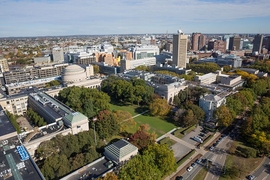MIT shared details on its plans for the fall semester in a public hearing on Tuesday with members of the Cambridge City Council.
The City Council’s Economic Development and University Relations Committee heard an overview from Cecilia Stuopis, director of MIT Medical; Suzanne Blake, director of MIT Emergency Management; and Sarah Gallop, co-director of MIT’s Office of Government and Community Relations. Representatives of Harvard University and Lesley University also participated in the hearing.
“We understand that the moment we are all grappling with is challenging, anxiety-producing, and constantly evolving,” Gallop said in her opening remarks. “Our approach is cautious and conservative.”
Gallop said that of 6,900 MIT graduate students eligible to be on campus this fall, nearly half have preregistered for courses. Roughly 1,700 of these students expect to live on campus this fall; of these, 900 are already on campus.
Among undergraduates, MIT has prioritized the return of two groups: seniors, who have the least time remaining to satisfy their degree requirements, and a small number of other students whose circumstances require special consideration given their safety, living conditions, visa status, or other hardship.
Gallop told members of the City Council that MIT expects to welcome a total of about 900 undergraduates from these two groups back to campus in late August. Overall, about 1,700 undergraduate and graduate students will return to campus for the fall, joining the 900 who have remained since the spring.
The view from MIT Medical
“MIT Medical has a long history of close collaboration with our colleagues at Cambridge Public Health to manage the myriad of public health concerns that typically might face an institution of higher education,” Stuopis said. “However, none have been as challenging as the current Covid-19 pandemic, which is requiring all of us to manage public health situations at a scale that is unprecedented.”
Stuopis described a campus risk management strategy that rests on four pillars: a low-density campus, daily health attestations, testing and tracing, and quarantine and isolation.
- Low-density campus: All students living in residence halls will have single-occupancy rooms, with no more than three students sharing each bathroom. Many classes will remain fully online, and most MIT employees will continue to work remotely throughout the fall semester. Strict physical distancing will be supported by predefined maximum densities for all classrooms, labs, and other shared spaces on campus, and face coverings will be required in all public areas.
- Daily health attestations: All students, faculty, and staff on campus will be required to complete a daily health attestation via MIT’s Covid Pass app, which is linked to the MIT ID cards that will govern access to campus buildings. Any reports of symptoms will be relayed to MIT Medical, and will result in automatic restrictions in access to academic buildings.
- Testing and tracing: Returning students will face Covid-19 testing stricter than what is required by the Commonwealth of Massachusetts: They will be tested immediately upon arrival, and then quarantine in their residence halls for five to seven days, until a second negative test result is confirmed. Newly arrived students will not have access to campus facilities, other than their residence halls, until they have received two negative test results; for undergraduates, only those living on campus this fall will be able to access MIT buildings for any reason. All community members living, studying, or working on campus will be required to undergo ongoing testing: twice weekly for students, and at least weekly for others, depending upon their risk factors.
- Quarantine and isolation: Students who test positive for Covid-19 will be isolated, and their close contacts will be quarantined. MIT has approximately 312 beds set aside for this purpose, including a dedicated residential support facility and isolation spaces across campus. MIT has also set aside sufficient capacity to provide off-campus students with the ability to isolate on campus, if necessary. MIT Medical will offer daily virtual check-ins for all students who are under quarantine and isolation protocols.
“Our comprehensive plan is intentionally conservative, and reflects our desire to be cautious with our return-to-campus plan,” Stuopis said. “It is paramount that MIT protect the health and well-being of all of its stakeholders, both on our campus and in our surrounding community.”
Emergency management preparations
Blake described the emergency operations MIT has set up to monitor and respond quickly to developments this fall. This summer, the Institute created a Covid-19 dashboard to track testing numbers, positive tests, reports of symptoms, numbers of individuals isolating on campus, and supplies of critical inventories, among other data. Several emergency response teams have been set up to monitor the situation; identify and manage cross-campus issues; decide on changes in operations; and implement any ramp-down of operations that may become necessary.
“The number of positives is not as important as the story behind the positives,” Blake said, describing a variety of factors that could influence a decision to reduce or suspend some campus operations. These could include conditions off campus, including a negative trend in the state’s Covid-19 health indicators; increased transmission within Cambridge; or orders from the Commonwealth of Massachusetts.
“We’ll never do something to a lesser extent than the Commonwealth, but we may do things to a greater extent,” she added.
On-campus factors that could trigger a ramp-down of operations include indications of community transmission; a cluster of cases; any death due to Covid-19; the nearing of MIT’s capacity to safely isolate or quarantine members of the community; or any infection rate that impacts essential teaching, research, or other operations.
Any ramp-down, Blake said, could apply to a particular building, department, lab, or work area; a single sector of the campus population, such as residential students, research staff, academic staff, or administrative staff; or more broadly across campus.
Blake described MIT’s close coordination with multiple points of contact within the City of Cambridge. The Institute’s first responders — MIT Police, MIT Emergency Management, and MIT EMS — hold weekly meetings with the Cambridge Police Department, Cambridge Fire Department, ProEMS, and the Harvard University Police Department. MIT Medical has a longstanding collaborative relationship with Cambridge’s Department of Public Health, and MIT’s Office of Government and Community Relations is in regular touch with the City Council, mayor, and city manager.
“All of our actions are guided by core principles, including protecting the health of our community and our neighbors; preserving our ability to deliver on MIT’s critical mission of teaching and research; and enabling students to stay on track in pursuit of their degrees,” Chancellor Cynthia Barnhart, who was unable to attend Tuesday’s hearing, wrote in a letter to city councilors. “Given the trajectory of the pandemic, we are confident that MIT’s approach to reopening is responsible, conservative, and cautious.”









